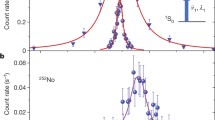Abstract.
For the investigation of the atomic level structure of heavy elements which can only be produced at on-line facilities such as GSI, a novel experimental procedure has been developed. It is based on Radiation Detected Resonance Ionization Spectroscopy (RADRIS) and can be applied to elements like nobelium produced at rates of a few ions per second. Fusion reaction products are separated from the primary beam by the velocity filter SHIP at GSI, stopped in a buffer gas cell, collected on a tantalum filament and then re-evaporated as atoms. The ions produced by resonance ionization with tunable laser beams are detected via their characteristic α decay. First on-line experiments on α-active 155Yb, which is supposed to have an atomic level structure similar to nobelium, were performed. These test experiments focused on the optimization of the collection and re-evaporation process of the radioactive ions, the laser ionization efficiency and the detection via α decay. An overall efficiency for RADRIS of 0.8% with respect to the target production rate was measured. While further improvements of this efficiency are in progress it should already be sufficient for the search for atomic levels in nobelium.
Similar content being viewed by others
References
M. Schädel, Angewandte Chemie-International Edition 45, 368 (2006)
A. Türler, Eur. Phys. J. A 15, 271 (2002)
H.W. Gäggeler, Eur. Phys. J. A 25, 583 (2005), Suppl. 1
R. Eichler et al., Radiochimica Acta 94, 181 (2006)
C.E. Düllmann et al., Nature 418, 859 (2002)
H.W. Gäggeler, Confirmation of the decay of $^{283}112$$ and evidence for a behaviour of element 112 as a volatile metal, in Workshop on the Atomic Properties of the Heaviest Elements (2006), http://www.ha.physik.uni-muenchen. de/heaviest_atoms/
V.G. Pershina, Chem. Rev. 96, 1977 (1996)
B. Fricke, E. Johnson, G. Rivera, Spectrochimica Acta 62, 17 (1993)
W.C. Martin, J. Sugar, Phys. Rev. A 53, 1911 (1996)
E. Eliav, U. Kaldor, Y. Ishikawa, Phys. Rev. Lett. 74, 1079 (1995)
W. Lauth, H. Backe, M. Dahlinger, I. Klaft, P. Schwamb, G. Schwickert, N. Trautmann, U. Othmer, Phys. Rev. Lett. 68, 1675 (1992)
H. Backe et al., Phys. Rev. Lett. 80, 920 (1998)
H. Backe, A. Dretzke, M. Hies, G. Kube, H. Kunz, W. Lauth, M. Sewtz, N. Trautmann, R. Repnow, H.J. Maier, Hyperfine Interact. 127, 35 (2000)
M. Sewtz et al., Phys. Rev. Lett. 90, 163002 (2003)
H. Backe et al., Nucl. Instrum. Meth. Phys. Res. B 126, 406 (1997)
H. Backe, A. Dretzke, S. Fritzsche, R.G. Haire, P. Kunz, W. Lauth, M. Sewtz, N. Trautmann, Hyperfine Interact. 162, 3 (2005)
M. Leino et al., Eur. Phys. J. A 6, 63 (1999)
H. Backe, W. Lauth, W. Achenbach, M. Hain, A. Scherer, A. Steinhof, S. Tölg, S. Ziegler, Nucl. Instrum. Meth. Phys. Res. B 70, 521 (1992)
W. Reisdorf, Z. Phys. A 300, 227 (1981)
B. Eichler, S. Hübener, N. Erdmann, K. Eberhard, H. Funk, G. Hermann, S. Köhler, N. Trautmann, G. Passler, F. Urban, Radiochim. Acta 79, 221 (1997)
M. Sewtz et al., Spectrochim. Acta B 58, 1077 (2003)
K. Rajnak, B. Shore, J. Opt. Soc. Am. 68, 360 (1978)
J. Sugar, J. Chem. Phys. 60, 4103 (1974)
N. Erdmann et al., J. Alloys Comp. 271, 837 (1998)
S. Fritzsche, Eur. Phys. J. D 33, 15 (2005)
A. Borschevsky, E. Eliav, M. Vilkas, Y. Ishikawa, U. Kaldor, Transition energies of Yb, Lu, No, and Lr by the intermediate Hamiltonian coupled cluster method, in Workshop on the Atomic Properties of the Heaviest Elements (2006), http://www.ha.physik.uni-muenchen. de/heaviest_atoms/
U. Kaldor, private communication, 2006
Author information
Authors and Affiliations
Corresponding author
Rights and permissions
About this article
Cite this article
Backe, H., Kunz, P., Lauth, W. et al. Towards optical spectroscopy of the element nobelium (\({\sf Z }= \mathsf{102}\)) in a buffer gas cell . Eur. Phys. J. D 45, 99–106 (2007). https://doi.org/10.1140/epjd/e2007-00198-1
Received:
Published:
Issue Date:
DOI: https://doi.org/10.1140/epjd/e2007-00198-1




